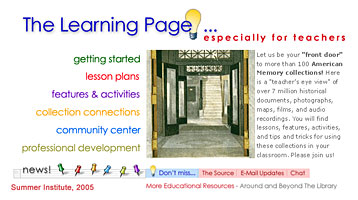talking history | syllabi | students | teachers | puzzle | about us
American Memory Learning Page
http://memory.loc.gov/ammem/ndlpedu/index.html
Library of Congress.
Reviewed Nov. 11–12, 2003.
Most of us have had time to catch our collective breath and come to terms with the Web as a blessing and a curse, with its unprecedented access to archival collections for research and unparalleled opportunities for cut-and-paste plagiarism, the promises fulfilled by the miraculous Google and the promises forestalled by frustrating surfing. American Memory—more than one hundred digital archival collections from the Library of Congress, comprising over seven million items—is an incredible resource for teachers and students, and we need help to make the most of this resource. In providing this help, the Learning Page is both a blessing and a curse.
The home page includes six primary links: Getting Started, Lesson Plans, Features and Activities, Collection Connections, Community Center, and Professional Development. Collection Connections is the substantive heart of the site. The index page includes a list of the collections (alphabetically by title) and a note about whether the site includes a “summary only” or “summary and teaching resources.” Even those with “summary only” (such as “Theodore Roosevelt: His Life and Times on Film”) give helpful hints about the scope of the collection, related collections and exhibits, and additional sources of information. Those with “teaching resources” provide selected quotations and images (with links) along with questions, activities, and suggestions of search terms for exploring the collection. These generative ideas will enable experienced teachers (and advanced high school students) to design focused research in the collections.

Finding archival materials on the topics being taught is only the beginning. Unfortunately, the site offers a confusing smorgasbord of generic guides for using primary sources. Under Getting Started we find “how to use primary sources,” in four overlapping versions. The site map (accessible not from the home page, but from Getting Started) shows additional guides called “Media analysis tools” (how to analyze primary sources), “Using primary sources in the classroom,” and “Historians' sources.” There are more guides available at the site’s online newsletter, the Source, and yet more under Professional Development workshops and handouts. This is more of a clutter than a helpful guide.
Speaking of clutter, I made the mistake of clicking on Features and Activities, which includes two “collaborative activities” and thirteen “activities” (the distinction is not clear), and then the Feature of “Immigration,” which took me to an animated show from which I could not return to the main site. I then checked out one of the Activities: “Become a historical detective,” where I was faced with five random questions (“True or False? Cattle have only been raised in the western part of the United States”) one click away from a page of answers.
More useful is the collection of sixty-seven Lesson Plans (in fact, units), which takes teachers and students into the archive through well-defined topics, themes, and questions. Other useful items such as copyright and technical information are located under Getting Started. The Community Center provides selected themes for live chats with other teachers. Professional Development includes a series of teachers' workshops, a “grab-bag” of handouts, and a listing of upcoming conferences.
Teachers who know what they are looking for will see the gold mine that is sitting under this site and have some patience sorting through the false leads and frills. For others, it would be nice to clean it up.
Peter Seixas
University of British Columbia
Vancouver, Canada
